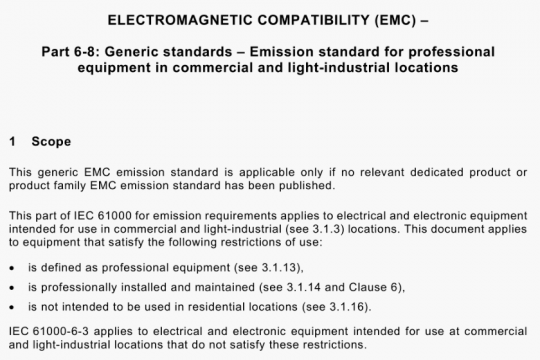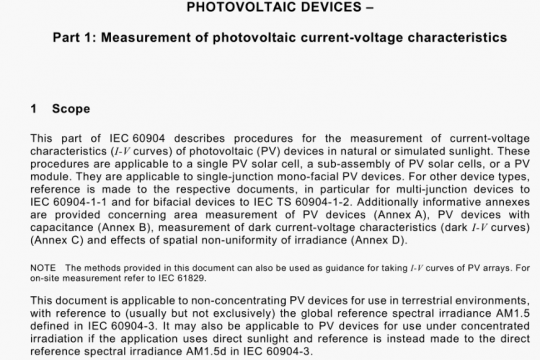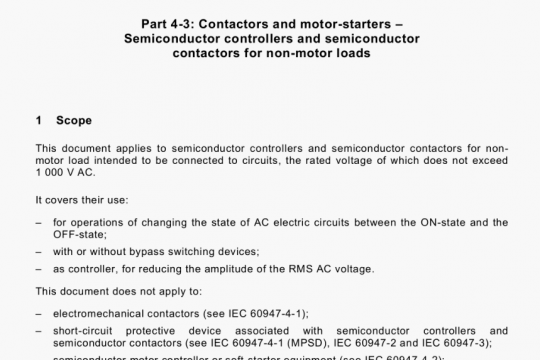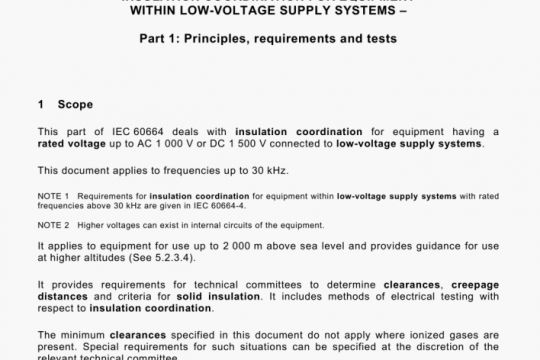IEC 60034-27-4-2018 pdf free download
IEC 60034-27-4-2018 pdf free download.Rotating electrical machines – Part 27-4: Measurement of insulation resistance and polarization index of winding insulation of rotating electrical machines.
This part of IEC 60034 provides recommended test procedures for the measurement of insulation resistance and polarization index of stator and rotor winding insulation of rotating electrical machines.
This document recommends minimum acceptable values of insulation resistance and polarization index of winding insulation valid for fully processed low and high voltage AC and DC rotating electrical machines with a rated power of 750 W or higher.
2 Normative references
The following documents are referred to in the text in such a way that some or all of their content constitutes requirements of this document. For dated references, only the edition cited applies. For undated references, the latest edition of the referenced document (including any amendments) applies.
IEC 60050-411, International Electrotechnical Vocabulary — Chapter 411: Rotating machinery
3 Terms and definitions
For the purposes of this document, the terms and definitions given in IEC 60050-411 and the following apply.
ISO and IEC maintain terminological databases for use in standardization at the following addresses:
• IEC Electropedia: available at http:l/www.electropedia.org/
• ISO Online browsing platform: available at http://www.iso.org/obp
4 Insulation resistance — components and influence factors
The insulation resistance of a rotating machine winding is a function of the type and condition of the insulating materials, the insulation system design and the techniques used to manufacture the winding.
The insulation resistance is measured with DC voltage. The measurement of the resistance over time provides information on current components caused by different physical mechanisms. Figure 1 is a schematic showing the different direct current components. Information on the various current components is provided in Annex A.
5 Polarization index
Variants of the polarization index definition with a quotient of insulation resistance of other measuring times may be used in special applications and need to be indicated (see Annex E). More measurement points during the 10 mm interval may yield additional information.
The polarization index describes the variation of the lR between two specific points in time and therefore, better than with a single insulation resistance value, it may indicate contamination and/or moisture deposition on the winding, or absorbed moisture in the winding. However, it may not indicate internal voids caused by improper impregnation or thermal deterioration.
The polarization index can be used to estimate the suitability of the winding for application of a voltage withstand test or for operation. It may provide information for assessing the condition of the insulation system.
Owing to the negligible polarization currents in the time interval from 1 mm to 10 mm, the determination of the polarization index may not apply for small machines with random-wound windings, for the field windings in generator rotors, for non-insulated field and squirrel-cage rotor windings and for DC machine armatures.
The polarization index depends on the type of the insulation system, especially on the nature of the insulation materials and procedures used for winding manufacture (for synthetic resin based or shellac- and asphalt based, see 7.1). Furthermore it depends on the kind of stress control coating (see Clause C.3) and the magnitude of the test voltage (see 6.4.1). The influence of the temperature on the polarization index is not significant under the condition that the winding temperature is constant between the 1 mm and 10 mm readings of the insulation resistance (see 6.1.2).
Before a winding is recommended for a voltage withstand test or for operation, the polarization index should have a minimum value (see recommendations in 8.3).
6 Measurement
6.1 Influences on the measurement of the insulation resistance
6.1.1 General
The resistance measurement result depends on environmental factors, mainly on the winding temperature and on the humidity content of the air. The winding temperature influence can be obtained from empirical data or an experimental measurement and used for the correction of measurement results taken at different temperatures (see 6.1.2).
The air relative humidity affects the surface leakage current and can usually not be estimated. as its effect further depends on the air temperature, surface properties of the insulation and the nature of any surface contamination. For this reason it is generally recommended to perform insulation resistance measurements at winding temperatures above the dew point.
6.1.2 Winding temperature correction
The variation of temperature affects all of the identified current components, except the capacitive current I, because an increase in temperature supplies thermal energy, which frees additional charge carriers and so reduces resistivity. Therefore the insulation resistance value of a winding depends on the winding temperature.IEC 60034-27-4 pdf free download.




